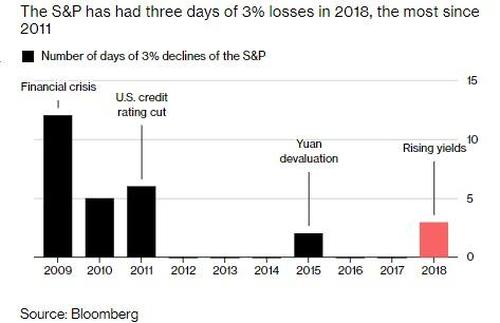In the aftermath of last week’s sharp selloff which saw the S&P drop more than 3% on Wednesday, the third such drop of the year bringing the number of YTD 3% loss days to three and the highest since 2011 as the market becomes increasingly fragilea debate has broken out among traders as to the source of the violent selloff, with humans blaming machines and vice versa.

For now, the prevailing consensus is that the bursts of selling which kicked in on Wednesday and Thursday just after 2 pm (but not Friday)…

… with the NYSE TICK print at 2:43pm on Thursday hitting the lowest since the May 2010 flash crash as the most aggressive sell program in over 8 years kicked in…

… were the result of deleveraging unwinds at vol-targeting, systematic funds such as risk-parity, CTAs, and variable annuities as the VIX spiked and key market support levels were breached, accelerated by option gamma hedging as the market continued to sink forcing dealers to sell to delta-hedge.

And so the next obvious question was whether the forced selling among the “machines” was over, with JPMorgan’s Marko Kolanovic writing on Friday that “CTAs have already executed the bulk of their selling, option hedging risk is now symmetric, and Volatility Targeters will sell over a longer period of time” and “that the majority of systematic selling is behind us (~70%)”, while Barclays’ strategist Manesh Deshpande, disagreed and predicted “further systematic selling to the tune of ~$130 billion from these funds to reduce allocation to equities over the next couple of days.”
A tie-breaker to both debates emerged late on Friday, when another JPMorgan market strategist, JPMorgan’s Nikolaos Panigirtzoglou, author of the popular weekly “Flows and Liquidity” note, suggested that in addition to the usual systematic selling suspects, risk parity funds, traditional Equity Long/Short hedge funds were also responsible for the sharp market downdraft.













Leave A Comment